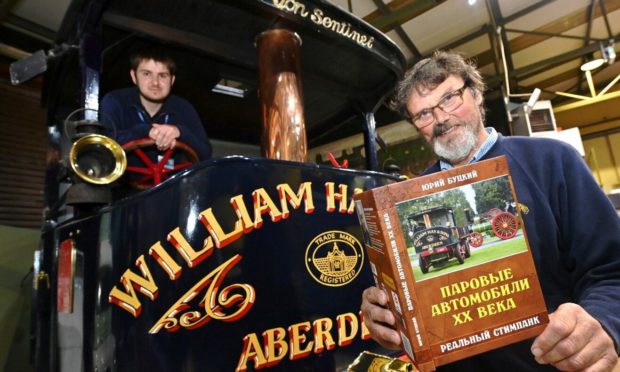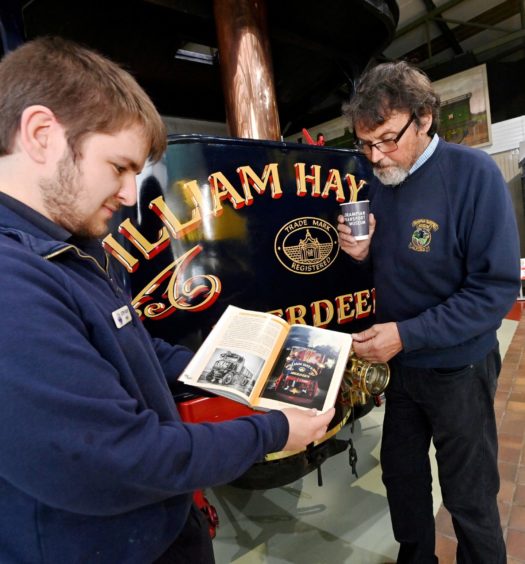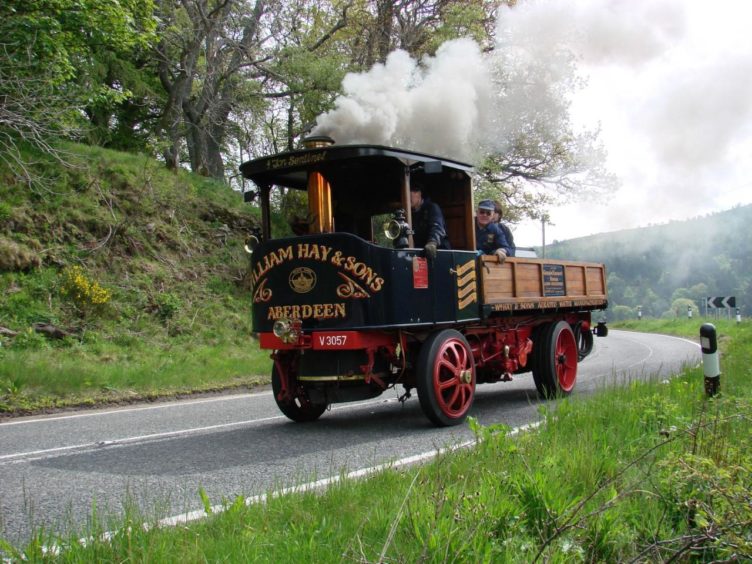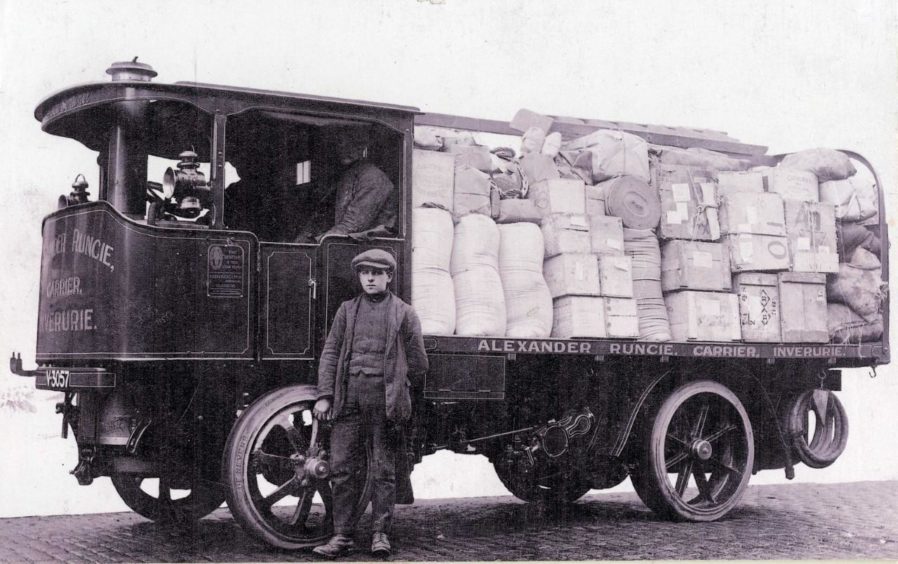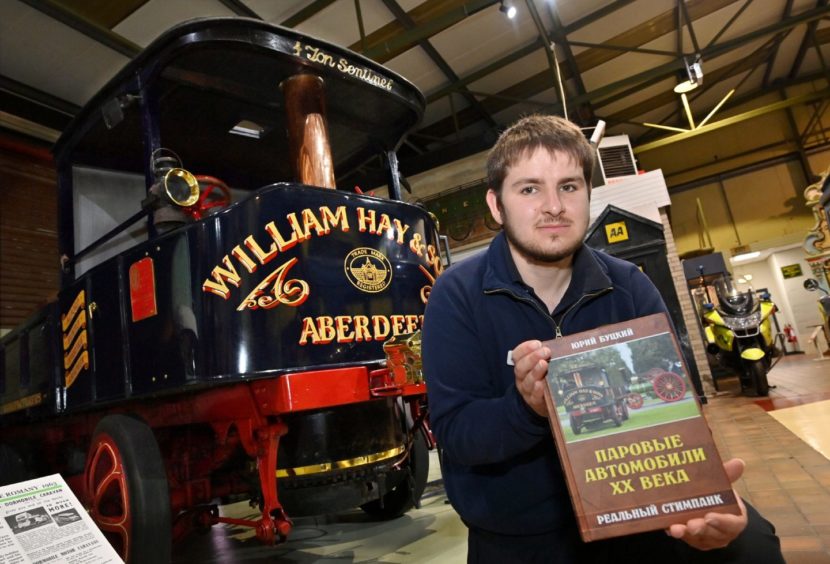It started out in January as a far-flung request for information from a Russian author to a north-east heritage organisation.
Now, six months later, a photograph of a vintage Sentinel steam waggon, which is the pride and joy of the Grampian Transport Museum, has appeared on the front cover of a prestigious new book by Yury Butsky.
Officials at the museum have been communicating with Comrade Butsky throughout the Covid pandemic and were delighted when a pristine copy of the coffee table publication arrived at their base this week.
Curator Mike Ward and his colleagues described the collaboration as a piece of “Glasnost in Grampian” and are thrilled that the vehicle they have cherished for many years is now taking centre stage in Russia.
The waggon, Sentinel Number 753, was constructed by engineering company Alley and MacLellan in Glasgow in 1914 and offered a refuge for youngsters and their families amid the horrors of the First World War.
It is the oldest vehicle of its kind in existence, the only surviving Scottish-built Sentinel, and, given its sparkling condition, always attracts admiring glances from the many visitors to the popular tourist venue.
Mr Ward said: “In 1905, Alley and MacLellan began to make steam waggons and they soon captured a large share of the market at the time with their undertype standard four-ton waggon.
“Increasing demand led to them relocating the waggon building to new purpose-built works in Shrewsbury in 1916.
“This Sentinel was sold new to Alexander Runcie, who worked as a carrier in Inverurie, and the vehicle spent its working life in the north east.
“By 1945, it was working with McIntosh of Forgue’s haulage fleet, based near Huntly, and eventually it was recovered from their yard and partly dismantled in 1966 for preservation.
“We are all very glad that this happened, because it is a very significant part of transport history and it is one of the favourite pieces in the museum.
“We were surprised to receive the message from Yury in the New Year, but we just couldn’t be happier with the way things have turned out.”
When Mr Ward and his colleague, Nick Webb, start talking about the Sentinel and its illustrious history, you can detect the excitement and enthusiasm these fellows derive from preserving and refurbishing mechanical crown jewels from the transport archives.
They have already thumbed through the pages of the Russian book and, while the language might be unfamiliar, the cover image of the waggon, emblazoned with the word Aberdeen, has brought a lump to their throats.
Mr Ward added: “Standard Sentinels were remarkably simple and robust steam waggons that featured an efficient vertical boiler whose steam-generating capacity, in the hands of an experienced fireman, gave the vehicle its advantage over its competitors.
“The small boiler ran at a relatively high pressure and delivered superheated steam to the eight-valve twin cylinder engine.
“These waggons were generally used with a trailer, enabling them to move loads of around 10 tons.
“From the mid-1920s, the design was refined with the introduction of the Super Sentinel and later, the DG type (Double Geared).
“In its final form, from 1934 onwards, the S type featured full electrics and it could run comfortably at 45mph with speeds of up to 60mph available.
“The last batch of Sentinel steamers left the works in 1956, bound for Argentina. By this time, the company had begun production of undertype motor lorries, but it doesn’t mean people stopped caring about the waggons.”
The waggon was far from just a commercial and business vehicle. More than 100 years ago, it cast a spell on many youngsters across Britain – and, as Yury Butsky has demonstrated, its appeal spread throughout the globe.
Mr Ward said: “There are great stories about the Sentinels, such as the time when they were used to take children on picnic excursions during the First World War to lift the mood as the death toll mounted on the Western front.
“The fact that it can still be steamed is remarkable. It makes you realise how hard lorry drivers worked at the start of the 20th Century!
“There is no doubt that it is the working exhibit which we have had the most fun with over the years.
“Giving rides to visitors at Balmoral Castle, taking it to local events and entertaining people here at the museum has really captured many folk’s imaginations and they have told us that.
“And the publication of this new book means that we might have a few visitors from Russia in the future, once people can travel freely again.”
Mr Webb explained how the partnership between the museum and Comrade Butsky has developed in recent months.
He said: “Yury contacted us at the beginning of 2021, asking for some information about the Sentinel, and was very interested in the whole subject.
“In addition to being a visitor attraction, we have a very important educational role and when he told us that his intended audience was school and university students, we were delighted to play a part in supplying him with more information. But we had no idea it would end up on the cover.
“This exhibit belongs to the museum wholly and was purchased years ago with a very early example of crowd funding and grants.
“Many members own a part of it, and each has a certificate as a donor.
“Mike loves it and drives it to steam fairs in ‘normal’ seasons and, while we are very proud of the many different artefacts which are in the collection, there is no doubt that the Sentinel stands out in so many different ways.”
The book is just the latest chapter in the story. From Russian with Love!
Visit www.gtm.org.uk for further information.
